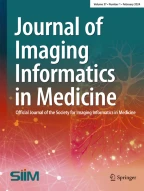Abstract
To facilitate follow-up of critical test results across transitions in patient care settings, we implemented an electronic discharge module that enabled care providers to include follow-up recommendations in the discharge instructions. We assessed the impact of this module on documentation of follow-up recommendations for critical imaging findings in Emergency Department (ED) discharge instructions. We studied 240 patients with critical imaging findings discharged from the ED before (n = 80) and after (n = 160) implementation of the module. We manually reviewed hand-written forms and electronic discharge instructions to determine if follow-up recommendations were documented. Follow-up recommendations in ED discharge instructions increased from 60.0% (48/80) to 73.8% (118/160) post-module implementation (p = 0.03), a relative increase of 23%. There was no significant change in the rate of documented critical imaging findings in the discharge instructions (77.5% [62/80] before the intervention and 76.9% [123/160] after the intervention; p = 0.91). Implementation of a discharge module was associated with increased documentation of critical imaging finding follow-up recommendations in ED discharge instructions. However, one in four patients still did not receive adequate follow-up recommendations, suggesting further opportunities for performance improvement exist.
Similar content being viewed by others
Explore related subjects
Discover the latest articles, news and stories from top researchers in related subjects.References
Vukmir RB, Kremen R, Ellis GL, DeHart DA, Plewa MC, Menegazzi J: Compliance with emergency department referral: The effect of computerized discharge instructions. Ann Emerg Med. 22(5):819–823, 1993
Sharp B, Singal B, Pulia M, Fowler J, Simmons S: You’ve got mail ... and need follow-up: The effect and patient perception of e-mail follow-up reminders after emergency department discharge. Acad Emerg Med. 22(1):47–53, 2015
Fletcher SW, Appel FA, Bourgois M: Improving emergency-room patient follow-up in a metropolitan teaching hospital. Effect of a follow-up check. N Engl J Med. 291(8):385–388, 1974
Scott KR, Milne WK, Arora S, Carpenter CR: Hot off the press: Post-emergency department automated messaging to improve follow-up compliance—what is the number needed to text? Acad Emerg Med. 22(5):639–641, 2015
Murray MJ, LeBlanc CH: Clinic follow-up from the emergency department: Do patients show up? Ann Emerg Med. 27(1):56–58, 1996
Rahman M, Dixit A, Donley V, Gupta S, Hanslik T, Lacson E, Ogundipe A, Weigel K, Smith MC: Factors associated with inadequate blood pressure control in hypertensive hemodialysis patients. Am J Kidney Dis. 33(3):498–506, 1999
Weiss AJ, Wier LM, Stocks C, Blanchard J: Overview of Emergency Department Visits in the United States, 2011: Statistical Brief #174. Healthcare Cost and Utilization Project (HCUP) Statistical Briefs. Rockville, 2006
You JJ, Laupacis A, Newman A, Bell CM: Non-adherence to recommendations for further testing after outpatient CT and MRI. Am J Med. 123(6):557–558, 2010
Caines LC, Brockmeyer DM, Tess AV, Kim H, Kriegel G, Bates CK: The revolving door of resident continuity practice: Identifying gaps in transitions of care. J Gen Intern Med. 26(9):995–998, 2011
van Walraven C, Taljaard M, Etchells E, Bell CM, Stiell IG, Zarnke K, Forster AJ: The independent association of provider and information continuity on outcomes after hospital discharge: Implications for hospitalists. J Hosp Med. 5(7):398–405, 2010
Anthony SG, Prevedello LM, Damiano MM, Gandhi TK, Doubilet PM, Seltzer SE, Khorasani R: Impact of a 4-year quality improvement initiative to improve communication of critical imaging test results. Radiology. 259(3):802–807, 2011
The Joint Commission. National Patient Safety Goals 2013.
Boohaker EA, Ward RE, Uman JE, McCarthy BD: Patient notification and follow-up of abnormal test results. A physician survey. Arch Intern Med. 156(3):327–331, 1996
Dutta S, Long WJ, Brown DF, Reisner AT: Automated detection using natural language processing of radiologists recommendations for additional imaging of incidental findings. Ann Emerg Med. 62(2):162–169, 2013
Bell EJ, Takhar SS, Beloff JR, Schuur JD, Landman AB: Information technology improves Emergency Department patient discharge instructions completeness and performance on a national quality measure: A quasi-experimental study. Appl Clin Inform. 4(4):499–514, 2013
Lacson R, O’Connor SD, Andriole KP, Prevedello LM, Khorasani R: An automated critical test result notification system: Architecture, design and assessment of provider satisfaction. AJR Am J Roentgenol, 2014
Lacson R, Prevedello LM, Andriole KP, O’Connor SD, Roy C, Gandhi T, Dalal AK, Sato L, Khorasani R: Four-year impact of an alert notification system on closed-loop communication of critical test results. AJR American journal of roentgenology. 203(5):933–938, 2014
Lacson R, O'Connor SD, Sahni VA, Roy C, Dalal A, Desai S, Khorasani R: Impact of an electronic alert notification system embedded in radiologists’ workflow on closed-loop communication of critical results: A time series analysis. BMJ Qual Saf, 2015
Poon EG, Gandhi TK, Sequist TD, Murff HJ, Karson AS, Bates DW: “I wish I had seen this test result earlier!”: Dissatisfaction with test result management systems in primary care. ArchInternMed. 164(20):2223–2228, 2004
Acknowledgements
The authors would like to thank Ms. Laura Peterson for reviewing the manuscript.
Funding
The study is supported by grant R21HS22586 from the Agency for Healthcare Research and Quality (AHRQ).
Author information
Authors and Affiliations
Corresponding author
Rights and permissions
About this article
Cite this article
Gupta, A., Lacson, R., Balthazar, P.C. et al. Assessing Documentation of Critical Imaging Result Follow-up Recommendations in Emergency Department Discharge Instructions. J Digit Imaging 31, 562–567 (2018). https://doi.org/10.1007/s10278-017-0039-6
Published:
Issue Date:
DOI: https://doi.org/10.1007/s10278-017-0039-6
